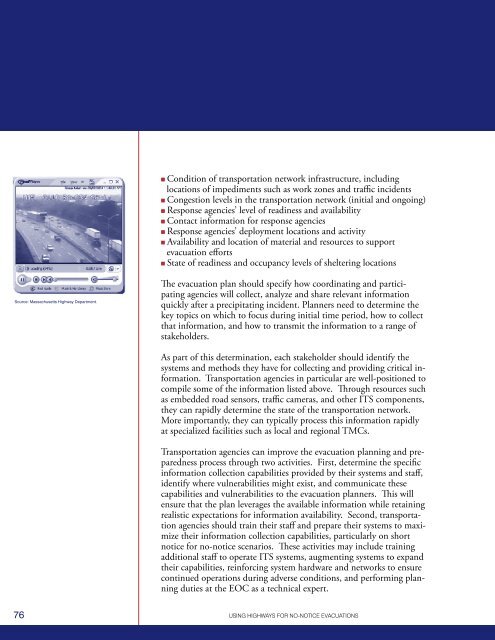using highways for no-notice evacuations - FHWA Operations - U.S. ...
using highways for no-notice evacuations - FHWA Operations - U.S. ...
using highways for no-notice evacuations - FHWA Operations - U.S. ...
Create successful ePaper yourself
Turn your PDF publications into a flip-book with our unique Google optimized e-Paper software.
n Condition of transportation network infrastructure, includinglocations of impediments such as work zones and traffic incidentsn Congestion levels in the transportation network (initial and ongoing)n Response agencies’ level of readiness and availabilityn Contact in<strong>for</strong>mation <strong>for</strong> response agenciesn Response agencies’ deployment locations and activityn Availability and location of material and resources to supportevacuation ef<strong>for</strong>tsn State of readiness and occupancy levels of sheltering locationsSource: Massachusetts Highway Department.The evacuation plan should specify how coordinating and participatingagencies will collect, analyze and share relevant in<strong>for</strong>mationquickly after a precipitating incident. Planners need to determine thekey topics on which to focus during initial time period, how to collectthat in<strong>for</strong>mation, and how to transmit the in<strong>for</strong>mation to a range ofstakeholders.As part of this determination, each stakeholder should identify thesystems and methods they have <strong>for</strong> collecting and providing critical in<strong>for</strong>mation.Transportation agencies in particular are well-positioned tocompile some of the in<strong>for</strong>mation listed above. Through resources suchas embedded road sensors, traffic cameras, and other ITS components,they can rapidly determine the state of the transportation network.More importantly, they can typically process this in<strong>for</strong>mation rapidlyat specialized facilities such as local and regional TMCs.Transportation agencies can improve the evacuation planning and preparednessprocess through two activities. First, determine the specificin<strong>for</strong>mation collection capabilities provided by their systems and staff,identify where vulnerabilities might exist, and communicate thesecapabilities and vulnerabilities to the evacuation planners. This willensure that the plan leverages the available in<strong>for</strong>mation while retainingrealistic expectations <strong>for</strong> in<strong>for</strong>mation availability. Second, transportationagencies should train their staff and prepare their systems to maximizetheir in<strong>for</strong>mation collection capabilities, particularly on short<strong>no</strong>tice <strong>for</strong> <strong>no</strong>-<strong>no</strong>tice scenarios. These activities may include trainingadditional staff to operate ITS systems, augmenting systems to expandtheir capabilities, rein<strong>for</strong>cing system hardware and networks to ensurecontinued operations during adverse conditions, and per<strong>for</strong>ming planningduties at the EOC as a technical expert.76USING HIGHWAYS FOR NO-NOTICE EVACUATIONS
















